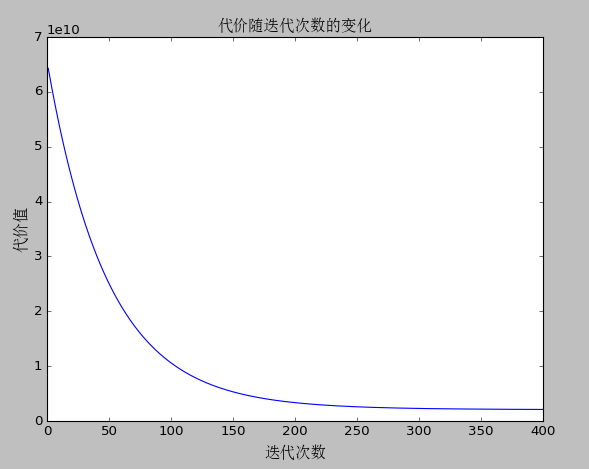{
"cells": [
{
"cell_type": "markdown",
"metadata": {},
"source": [
"## 一、[线性回归](code/1-LinearRegression)\n",
"- [全部代码](../code/1-LinearRegression/LinearRegression.py)\n",
"\n",
"### 1、代价函数\n",
"- \n",
"- 其中:\n",
"\n",
"\n",
"- 下面就是要求出theta,使代价最小,即代表我们拟合出来的方程距离真实值最近\n",
"- 共有m条数据,其中代表我们要拟合出来的方程到真实值距离的平方,平方的原因是因为可能有负值,正负可能会抵消\n",
"- 前面有系数`2`的原因是下面求梯度是对每个变量求偏导,`2`可以消去\n",
"\n",
"- 实现代码:"
]
},
{
"cell_type": "code",
"execution_count": null,
"metadata": {
"collapsed": true
},
"outputs": [],
"source": [
"# 计算代价函数\n",
"def computerCost(X,y,theta):\n",
" m = len(y)\n",
" J = 0\n",
" \n",
" J = (np.transpose(X*theta-y))*(X*theta-y)/(2*m) #计算代价J\n",
" return J"
]
},
{
"cell_type": "markdown",
"metadata": {},
"source": [
"- 注意这里的X是真实数据前加了一列1,因为有theta(0)\n",
"\n",
"### 2、梯度下降算法\n",
"- 代价函数对求偏导得到: \n",
"![\\frac{{\\partial J(\\theta )}}{{\\partial {\\theta _j}}} = \\frac{1}{m}\\sum\\limits_{i = 1}^m {[({h_\\theta }({x^{(i)}}) - {y^{(i)}})x_j^{(i)}]} ](http://chart.apis.google.com/chart?cht=tx&chs=1x0&chf=bg,s,FFFFFF00&chco=000000&chl=%5Cfrac%7B%7B%5Cpartial%20J%28%5Ctheta%20%29%7D%7D%7B%7B%5Cpartial%20%7B%5Ctheta%20_j%7D%7D%7D%20%3D%20%5Cfrac%7B1%7D%7Bm%7D%5Csum%5Climits_%7Bi%20%3D%201%7D%5Em%20%7B%5B%28%7Bh_%5Ctheta%20%7D%28%7Bx%5E%7B%28i%29%7D%7D%29%20-%20%7By%5E%7B%28i%29%7D%7D%29x_j%5E%7B%28i%29%7D%5D%7D%20)\n",
"- 所以对theta的更新可以写为: \n",
"![{\\theta _j} = {\\theta _j} - \\alpha \\frac{1}{m}\\sum\\limits_{i = 1}^m {[({h_\\theta }({x^{(i)}}) - {y^{(i)}})x_j^{(i)}]} ](http://chart.apis.google.com/chart?cht=tx&chs=1x0&chf=bg,s,FFFFFF00&chco=000000&chl=%7B%5Ctheta%20_j%7D%20%3D%20%7B%5Ctheta%20_j%7D%20-%20%5Calpha%20%5Cfrac%7B1%7D%7Bm%7D%5Csum%5Climits_%7Bi%20%3D%201%7D%5Em%20%7B%5B%28%7Bh_%5Ctheta%20%7D%28%7Bx%5E%7B%28i%29%7D%7D%29%20-%20%7By%5E%7B%28i%29%7D%7D%29x_j%5E%7B%28i%29%7D%5D%7D%20)\n",
"- 其中为学习速率,控制梯度下降的速度,一般取**0.01,0.03,0.1,0.3.....**\n",
"- 为什么梯度下降可以逐步减小代价函数\n",
" - 假设函数`f(x)`\n",
" - 泰勒展开:`f(x+△x)=f(x)+f'(x)*△x+o(△x)`\n",
" - 令:`△x=-α*f'(x)` ,即负梯度方向乘以一个很小的步长`α`\n",
" - 将`△x`代入泰勒展开式中:`f(x+x)=f(x)-α*[f'(x)]²+o(△x)`\n",
" - 可以看出,`α`是取得很小的正数,`[f'(x)]²`也是正数,所以可以得出:`f(x+△x)<=f(x)`\n",
" - 所以沿着**负梯度**放下,函数在减小,多维情况一样。\n",
"- 实现代码"
]
},
{
"cell_type": "code",
"execution_count": null,
"metadata": {
"collapsed": true
},
"outputs": [],
"source": [
"# 梯度下降算法\n",
"def gradientDescent(X,y,theta,alpha,num_iters):\n",
" m = len(y) \n",
" n = len(theta)\n",
" \n",
" temp = np.matrix(np.zeros((n,num_iters))) # 暂存每次迭代计算的theta,转化为矩阵形式\n",
" \n",
" \n",
" J_history = np.zeros((num_iters,1)) #记录每次迭代计算的代价值\n",
" \n",
" for i in range(num_iters): # 遍历迭代次数 \n",
" h = np.dot(X,theta) # 计算内积,matrix可以直接乘\n",
" temp[:,i] = theta - ((alpha/m)*(np.dot(np.transpose(X),h-y))) #梯度的计算\n",
" theta = temp[:,i]\n",
" J_history[i] = computerCost(X,y,theta) #调用计算代价函数\n",
" print '.', \n",
" return theta,J_history "
]
},
{
"cell_type": "markdown",
"metadata": {},
"source": [
"### 3、均值归一化\n",
"- 目的是使数据都缩放到一个范围内,便于使用梯度下降算法\n",
"- \n",
"- 其中  为所有此feture数据的平均值\n",
"- 可以是**最大值-最小值**,也可以是这个feature对应的数据的**标准差**\n",
"- 实现代码:"
]
},
{
"cell_type": "code",
"execution_count": null,
"metadata": {
"collapsed": true
},
"outputs": [],
"source": [
"# 归一化feature\n",
"def featureNormaliza(X):\n",
" X_norm = np.array(X) #将X转化为numpy数组对象,才可以进行矩阵的运算\n",
" #定义所需变量\n",
" mu = np.zeros((1,X.shape[1])) \n",
" sigma = np.zeros((1,X.shape[1]))\n",
" \n",
" mu = np.mean(X_norm,0) # 求每一列的平均值(0指定为列,1代表行)\n",
" sigma = np.std(X_norm,0) # 求每一列的标准差\n",
" for i in range(X.shape[1]): # 遍历列\n",
" X_norm[:,i] = (X_norm[:,i]-mu[i])/sigma[i] # 归一化\n",
" \n",
" return X_norm,mu,sigma"
]
},
{
"cell_type": "markdown",
"metadata": {},
"source": [
"- 注意预测的时候也需要均值归一化数据\n",
"\n",
"### 4、最终运行结果\n",
"- 代价随迭代次数的变化 \n",
"\n",
"\n",
"\n",
"### 5、使用scikit-learn库中的线性模型实现\n",
"- [全部代码](../../code/1-LinearRegression/LinearRegression_scikit-learn.py)\n",
"- 导入包"
]
},
{
"cell_type": "code",
"execution_count": null,
"metadata": {
"collapsed": true
},
"outputs": [],
"source": [
"from sklearn import linear_model\n",
"from sklearn.preprocessing import StandardScaler #引入缩放的包"
]
},
{
"cell_type": "markdown",
"metadata": {},
"source": [
"- 归一化"
]
},
{
"cell_type": "code",
"execution_count": null,
"metadata": {
"collapsed": true
},
"outputs": [],
"source": [
" # 归一化操作\n",
"scaler = StandardScaler() \n",
"scaler.fit(X)\n",
"x_train = scaler.transform(X)\n",
"x_test = scaler.transform(np.array([1650,3]))"
]
},
{
"cell_type": "markdown",
"metadata": {},
"source": [
"- 线性模型拟合"
]
},
{
"cell_type": "code",
"execution_count": null,
"metadata": {
"collapsed": true
},
"outputs": [],
"source": [
"# 线性模型拟合\n",
"model = linear_model.LinearRegression()\n",
"model.fit(x_train, y)"
]
}
],
"metadata": {
"kernelspec": {
"display_name": "Python 2",
"language": "python",
"name": "python2"
},
"language_info": {
"codemirror_mode": {
"name": "ipython",
"version": 2
},
"file_extension": ".py",
"mimetype": "text/x-python",
"name": "python",
"nbconvert_exporter": "python",
"pygments_lexer": "ipython2",
"version": "2.7.13"
}
},
"nbformat": 4,
"nbformat_minor": 2
}